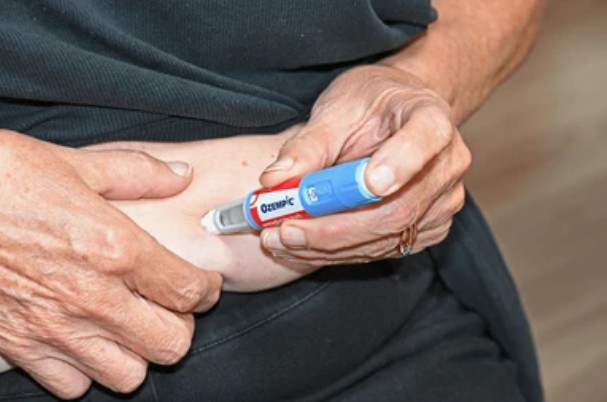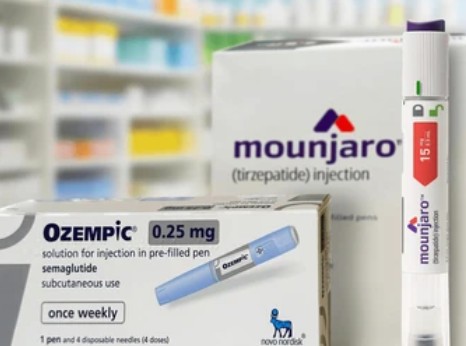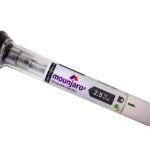Controlling diabetes and weight can be the hardest part, but new treatments like Ozempic and Mounjaro, and other GLP-1 specifics are giving people a fresh relief.
These drugs are gaining attention for their benefits, but it’s important to understand how they work, their side effects, and how they compare.
This quick guide will help you get the basics easily and simply.
What Is Ozempic?
Ozempic (semaglutide) is a once-daily injection used to help people with type 2 diabetes manage their blood sugar levels. Over time, many also noticed it helped check appetite and support weight loss.
Ozempic is a GLP-1 receptor agonist used to ameliorate blood sugar control in type 2 diabetes and support weight loss. It’s taken as a once-daily injection.
While Ozempic isn’t officially approved for weight loss, it’s frequently prescribed for that purpose, analogous to Wegovy, which contains the same active component.
How Does Ozempic Work?
Ozempic workshop by copying the conduct of a hormone in your body called GLP-1 (Glucagon-Like Peptide-1- 1). This hormone is naturally released after you eat and helps regulate blood sugar and appetite.
Impact of taking Ozempic:
- It helps your pancreas release insulin when your blood sugar is high.
- It tells your liver to stop releasing extra sugar into your bloodstream.
- It slows down the emptying of your stomach, so you feel full longer.
- It signals your brain to reduce your appetite and cravings.
This combination makes it easier to eat smaller portions, feel full faster, and naturally lower blood sugar levels without sharp drops.

Ozempic for Weight Loss
Although Ozempic was made to treat type 2 diabetes, numerous people now use it to help with weight loss.
What’s unique about Ozempic is that it doesn’t cause strict overeating. People frequently say they just feel satisfied sooner and no longer think about food as much. Jones for snacks and sweets tends to fade, and reflections feel filling indeed in lower quantities.
The weight loss from Ozempic happens sluggishly and steadily, which is actually a safer and healthier way to lose weight. People generally lose between 5% and 15% of their body weight over several months.
For those whose main thing is weight loss, croakers
occasionally recommend Wegovy, which is basically the same drug but is approved specifically for weight loss.
Common Side Effects of Ozempic
When starting Ozempic, numerous people notice mild side effects like nausea, vomiting, constipation, diarrhea, headaches, or feeling surprisingly tired.
These tend to fade as your body gets used to the drug. Starting with a lower calorie and eating lower, lighter refectives can make the adaptation easier.
Many people also notice changes in mood or mental well-being while using these medications, and recent Australian guidance highlights the importance of monitoring for such effects with weight-loss injections.

Serious Side Effects
Serious problems with Ozempic are rare but possible. Watch for severe stomach pain, signs of pancreatitis, gallbladder trouble, low blood sugar, or unusual lumps in the neck, which may point to thyroid issues.
However, communicate your croaker straight down if anything feels wrong or worrying.
Things to consider before Ozempic intake
Side effects usually settle with time, but it’s important to keep in touch with your doctor for regular checks. Always speak up if symptoms don’t go away or feel severe; early action keeps your treatment safe and effective.
Mounjaro vs Ozempic: How Do They Differ?
Mounjaro (tirzepatide) is a newer medication that’s also used to manage type 2 diabetes and support weight loss. It works similarly to Ozempic but targets two hormones instead of one. This may help people feel even fuller and lose weight a little faster.
While Ozempic focuses on the GLP-1 hormone, Mounjaro targets GLP-1 and GIP hormones, which may offer more powerful appetite control for some users.

Both medications are weekly injections and have similar digestive side effects. Some studies suggest that Mounjaro might lead to slightly more weight loss than Ozempic, but both options are highly effective and can make a real difference.
The best choice depends on your health history, weight loss goals, insurance coverage, and your doctor’s recommendation.
How to Get Ozempic?
Ozempic is a prescription medication, so you can’t buy it over the counter. The first step is to speak with your doctor, either in person or through a telehealth service. They’ll check your health history and decide if Ozempic is right for you.
If prescribed, you can pick it up from your local pharmacy or order it from a trusted online pharmacy recommended by your doctor. It’s important to always use safe, verified sources to make sure you’re getting the real medication.
How Much does Ozempic cost?
Without insurance, Ozempic is expensive. The typical Ozempic cost is between $800 and $1,200 per month. This can be a financial barrier for many people.
For those with insurance coverage, the monthly cost can be much lower, sometimes around $25 to $100, depending on the plan.
The manufacturer, Novo Nordisk, offers savings cards and patient support programs that may help reduce costs. There are also discount services like GoodRx that can lower prices further.
It’s helpful to compare prices at different pharmacies and ask your doctor or pharmacist about all available savings options.
Starting Ozempic is often part of a personal journey to feel better and improve health. It’s normal to have questions, but with the right support, clear information, and guidance from a trusted doctor, the process can feel simpler and more manageable. Every small step matters.
Quick Answers About Ozempic
What should I do if I miss a dose?
If you miss a dose, you can take it within 5 days. If more than 5 days have passed, just skip that dose and take the next one as scheduled. It’s always good to double-check with your doctor or pharmacist.
How quickly does Ozempic start working?
Some people notice their appetite shrinking within the first week. Blood sugar improvements usually begin soon after starting, but weight loss tends to be gradual over several weeks or months.
Can we use Ozempic for weight loss without diabetes?
Yes, many people use Ozempic for weight loss even if they don’t have diabetes. Doctors often prescribe it off-label, though Wegovy is the version officially approved for weight loss.






